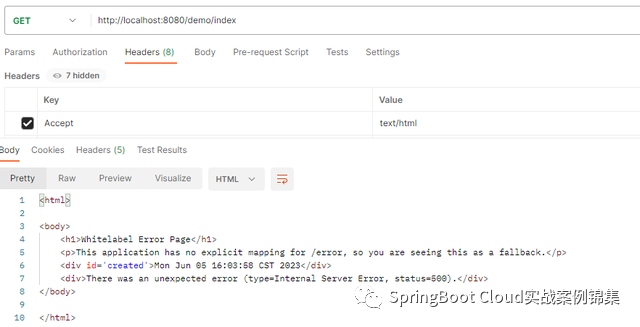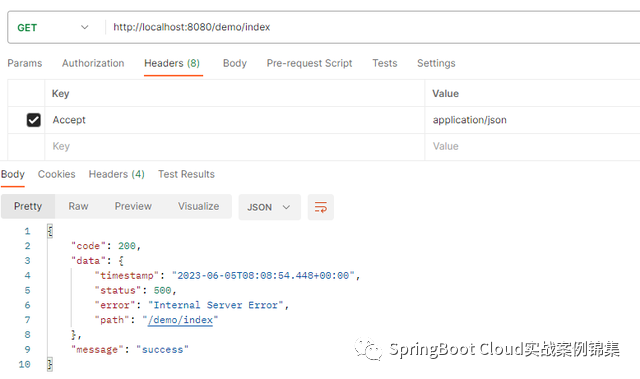SpringBoot错误页面的原理,你知道吗?
环境:Springboot3.0.5
错误消息格式
有如下接口:
@RestController
@RequestMapping("/demo")
public class DemoController {
@GetMapping("/index")
public Object index() {
System.out.println(1 / 0) ;
return "/demo/index" ;
}
}当访问上面接口后,默认情况下Springboot会返回如下错误信息:

当请求的Accept是text/html返回的是HTML结果,当Accpet是application/json返回如下:

后台接口会根据不同的Accept返回不同的数据格式。
错误处理原理
Springboot在启动过程中会执行如下处理:
public abstract class AbstractApplicationContext {
public void refresh() {
onRefresh();
}
}ServletWebServerApplicationContext
public class ServletWebServerApplicationContext {
protected void onRefresh() {
super.onRefresh();
try {
// 创建web服务
createWebServer();
} catch (Throwable ex) {
throw new ApplicationContextException("Unable to start web server", ex);
}
}
private void createWebServer() {
// 这里假设我们使用的是Tomcat容器,那么这里的factory = TomcatServletWebServerFactory
this.webServer = factory.getWebServer(getSelfInitializer());
}
}TomcatServletWebServerFactory
public class TomcatServletWebServerFactory {
public WebServer getWebServer(ServletContextInitializer... initializers) {
// 创建Tomcat实例
Tomcat tomcat = new Tomcat();
// ...
// 准备上下文
prepareContext(tomcat.getHost(), initializers);
return getTomcatWebServer(tomcat);
}
protected void prepareContext(Host host, ServletContextInitializer[] initializers) {
// 该类继承自StandardContext类(该类所属tomcat,每一个StandardContext代表了一个webapp)
TomcatEmbeddedContext context = new TomcatEmbeddedContext();
// ...
// 配置上下文
configureContext(context, initializersToUse);
}
// 配置上下文
protected void configureContext(Context context, ServletContextInitializer[] initializers) {
// 获取当前Spring容器中配置的ErrorPage,然后注册到Tomcat当前webapp的上下文中
// 这里其实对应的就是web.xml中配置的错误页
for (ErrorPage errorPage : getErrorPages()) {
org.apache.tomcat.util.descriptor.web.ErrorPage tomcatErrorPage = new org.apache.tomcat.util.descriptor.web.ErrorPage();
tomcatErrorPage.setLocation(errorPage.getPath());
tomcatErrorPage.setErrorCode(errorPage.getStatusCode());
tomcatErrorPage.setExceptionType(errorPage.getExceptionName());
context.addErrorPage(tomcatErrorPage);
}
}
}TomcatServletWebServerFactory类实现了ErrorPageRegistry接口,有如下方法:
// TomcatServletWebServerFactory继承自AbstractConfigurableWebServerFactory
// ConfigurableWebServerFactory接口继承了ErrorPageRegistry接口
public abstract class AbstractConfigurableWebServerFactory implements ConfigurableWebServerFactory {
public void addErrorPages(ErrorPage... errorPages) {
this.errorPages.addAll(Arrays.asList(errorPages));
}
}下面查看上面的addErrorPages方法是如何被调用的。
在自动配置类中导入了下面的类
@Import({ ServletWebServerFactoryAutoConfiguration.BeanPostProcessorsRegistrar.class})
public class ServletWebServerFactoryAutoConfiguration {
}
// BeanPostProcessorsRegistrar实现了ImportBeanDefinitionRegistrar,用来注册Bean
public static class BeanPostProcessorsRegistrar implements ImportBeanDefinitionRegistrar, BeanFactoryAware {
public void registerBeanDefinitions(AnnotationMetadata importingClassMetadata, BeanDefinitionRegistry registry) {
// 注册了BeanPostProcessor类ErrorPageRegistrarBeanPostProcessor
registerSyntheticBeanIfMissing(registry, "errorPageRegistrarBeanPostProcessor", ErrorPageRegistrarBeanPostProcessor.class);
}
}
public class ErrorPageRegistrarBeanPostProcessor implements BeanPostProcessor, BeanFactoryAware {
public Object postProcessBeforeInitialization(Object bean, String beanName) throws BeansException {
// 判断当前的Bean是否实现了ErrorPageRegistry
if (bean instanceof ErrorPageRegistry errorPageRegistry) {
postProcessBeforeInitialization(errorPageRegistry);
}
return bean;
}
private void postProcessBeforeInitialization(ErrorPageRegistry registry) {
// 遍历所有的ErrorPageRegistrar,注册到当前实现了ErrorPageRegistry接口的Bean中
// 如上面的TomcatServletWebServerFactory
for (ErrorPageRegistrar registrar : getRegistrars()) {
registrar.registerErrorPages(registry);
}
}
private Collection<ErrorPageRegistrar> getRegistrars() {
if (this.registrars == null) {
// 获取容器中所有的ErrorPageRegistrar Bean对象
this.registrars = new ArrayList<>(this.beanFactory.getBeansOfType(ErrorPageRegistrar.class, false, false).values());
this.registrars.sort(AnnotationAwareOrderComparator.INSTANCE);
this.registrars = Collections.unmodifiableList(this.registrars);
}
return this.registrars;
}
}接下来就是从容器中获取ErrorPageRegistrar,然后注册到ErrorPageRegistry中。
在如下自动配置类中定义了一个默认的错误页对象。
public class ErrorMvcAutoConfiguration {
@Bean
public ErrorPageCustomizer errorPageCustomizer(DispatcherServletPath dispatcherServletPath) {
return new ErrorPageCustomizer(this.serverProperties, dispatcherServletPath);
}
static class ErrorPageCustomizer implements ErrorPageRegistrar, Ordered {
// springboot配置文件中的server接口中获取error配置信息
private final ServerProperties properties;
private final DispatcherServletPath dispatcherServletPath;
protected ErrorPageCustomizer(ServerProperties properties, DispatcherServletPath dispatcherServletPath) {
this.properties = properties;
this.dispatcherServletPath = dispatcherServletPath;
}
@Override
public void registerErrorPages(ErrorPageRegistry errorPageRegistry) {
// 获取server.error.path配置属性
ErrorPage errorPage = new ErrorPage(this.dispatcherServletPath.getRelativePath(this.properties.getError().getPath()));
errorPageRegistry.addErrorPages(errorPage);
}
}
}
@ConfigurationProperties(prefix = "server", ignoreUnknownFields = true)
public class ServerProperties {
@NestedConfigurationProperty
private final ErrorProperties error = new ErrorProperties();
}
public class ErrorProperties {
// 读取error.path配置,如果没有配置,则默认是/error
@Value("${error.path:/error}")
private String path = "/error";
}通过上面的分析,默认情况下springboot容器启动后会像tomcat容器中注册一个/error的错误页,这个/error又是谁呢?
默认错误Controller
在默认的错误页自动配置中:
public class ErrorMvcAutoConfiguration {
@Bean
@ConditionalOnMissingBean(value = ErrorAttributes.class, search = SearchStrategy.CURRENT)
public DefaultErrorAttributes errorAttributes() {
return new DefaultErrorAttributes();
}
// 该Controller就是默认的/error错误跳转的类
@Bean
@ConditionalOnMissingBean(value = ErrorController.class, search = SearchStrategy.CURRENT)
public BasicErrorController basicErrorController(ErrorAttributes errorAttributes, ObjectProvider<ErrorViewResolver> errorViewResolvers) {
return new BasicErrorController(errorAttributes, this.serverProperties.getError(),errorViewResolvers.orderedStream().toList());
}
}
@Controller
@RequestMapping("${server.error.path:${error.path:/error}}")
public class BasicErrorController extends AbstractErrorController {
// 当请求的Accept=text/html时调用该方法
@RequestMapping(produces = MediaType.TEXT_HTML_VALUE)
public ModelAndView errorHtml(HttpServletRequest request, HttpServletResponse response) {
// ...
}
// 当请求的Accept=application/json时调用该方法
@RequestMapping
public ResponseEntity<Map<String, Object>> error(HttpServletRequest request) {
HttpStatus status = getStatus(request);
if (status == HttpStatus.NO_CONTENT) {
return new ResponseEntity<>(status);
}
Map<String, Object> body = getErrorAttributes(request, getErrorAttributeOptions(request, MediaType.ALL));
return new ResponseEntity<>(body, status);
}
}以上就是当springboot默认情况下发生错误时的执行输出原理。
© 版权声明
文章版权归作者所有,未经允许请勿转载。



